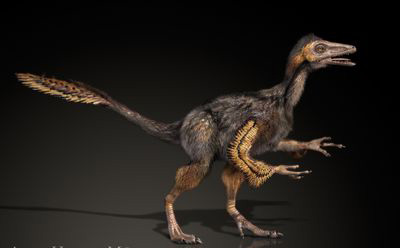Yixianosaurus (phonetically spelled Yi-chow-oh-sore-us) is a Yixian lizard of Longimanus type species dinosaur named by Xu Xing and Wang Xiaolin in 2003. The classification of the species is as follows:
Chordata – Reptilia – Dinosauria – Saurischia – Theropoda– Tetanurae – Coelurosauria – Maniraptora
The estimated size of the Yixianosaurus is about 1 meter long and they probably followed an insectivorous diet. The know location of this species is Liaoning in China. They existed during the Barremian period of the Cretaceous era. The fossil representations include the forelimbs, shoulder, some ribs, gastralia and feathers. These are the only fossils found so far. The generic name of this species refers to the Yixian Formation. The specific name means "with a long hand" from Latin longus, "long", and manus, "hand". Yixianosaurus longimanus, was formally named and described by Xu Xing and Wang Xiaolin in 2003.

Yixianosaurus's skeleton was discovered in 2001, in Liaoning at Wangjiagou in northeastern China. It is known only from a single specimen, holotype IVPP V12638, which likely derived from the Dawangzhangzi Bed of the early Aptian stage, 122 million years ago. The fossil is a compression fossil, preserved on a single slab that however has been sawed into several pieces. The fossil consists of the shoulder girdle together with a pair of fossilized arms complete with fossilized feathers and some ribs and gastralia.
Yixianosaurus has been estimated to have a very long hand, 140% of the length of the 89 millimetres long humerus. The second finger is the longest. The fingers bear large and recurved claws. The large hands could have served in catching prey or assisted climbing. The total body length has been estimated at 1 metre, the weight at 1 kilogram. The feathers are not preserved well enough to show a specific structure, but they appear similar to the contour feathers of some Yixian Formation birds.
| Name: | Yixianosaurus (Yixian lizard). |
| Phonetic: | Yi-chow-oh-sore-us. |
| Fossil representation: | The forelimbs, shoulder, some ribs, gastralia and feathers are all that are so far known. |